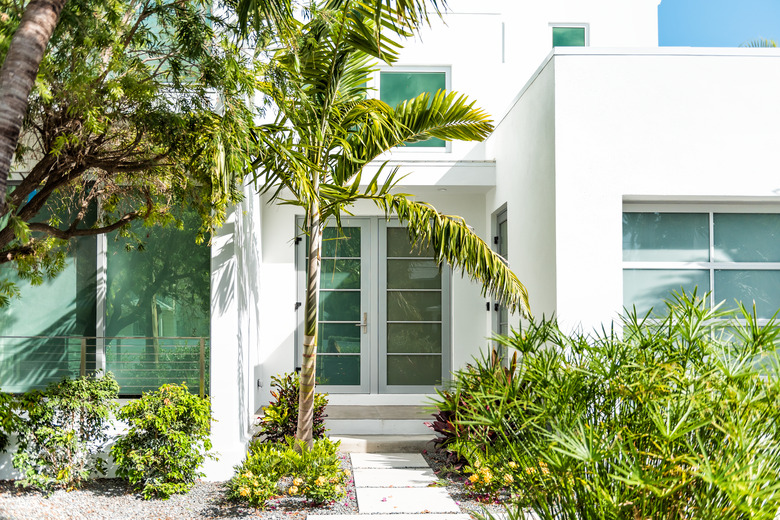What Kind Of Plants Go With Palm Trees?
If you're dreaming of a lush tropical garden, palm trees are the key to achieving a verdant look. Palm trees can actually survive in northern climates as long as winter temperatures don't drop below 25 degrees Fahrenheit. Palm trees, depending on the species, are hardy in U.S. Department of Agriculture plant hardiness zones 6 through 12. By planting a variety of different palm trees and incorporating the kinds of plants that go well with palm trees, such as ferns and bromeliads, you can design a tropical landscape for your garden.
Tip
Choose companion plants for palm trees that thrive in the palms' USDA zones in addition to providing color and texture to your tropical garden.
Varying the Tropical Palms
Add interest to your tropical garden by using different varieties of palm trees. Some shorter palms such as the Chinese windmill palm (Trachycarpus fortunei) give the appearance of a shrub or a bush with divided leaves. It grows slowly up to 20 feet tall in most landscapes and can spread up to 4 feet across. If a smaller palm tree is desired, dwarf palmettos (Sabal minor) grow to only 10 feet. Both are hardy in USDA zones 7 through 11.
The short, full Mazari palm tree (Nannorrhops ritchiana), featuring dramatic fan-shaped leaves with deep serration, is a good choice in USDA zones 6b through 11. The needle palm (Rhapidophyllum hystrix), a dramatic tropical shrub-like tree, is considered the most cold-tolerant palm tree known, hardy in USDA zones 6 through 10.
Choosing Tropical Plants
When you plan your tropical garden, select the palm trees first, then think about creating an interesting grouping using tropical plants to go along with the trees. It's important to find out how large each plant will be when it matures. Mix smaller plants among the larger varieties and juxtapose a plant with thin leaf sections — such as the needle palm — with a plant that has broad leaves, such as a bird of paradise (Strelitzia reginae), hardy in USDA zones 10 through 12.
Alternately, include a bougainvillea (Bougainvillea spp.) with small, rounded leaves near a plant with narrow leaves, such as the needle palm, in USDA zones 9 through 11. Not only will the leaf shape add contrast with the palm tree's leaves, but the vibrant red flowers add a tropical feel to the garden.
Climbing Vines and Low Plants
Use an assortment of low tropical plants to add textural interest. The dark, shiny leaves of climbing jasmine vines (Jasminum officinale) accent the grouping around the palm tree nicely in USDA zones 7 through 10. For color, add vivid caladiums (Caladium, zones 9-10), crotons (Codiaeum variegatum, zones 11-12) and ti plants (Cordyline fruticosa, zones 10-12) around the base of the palm.
If you have a pathway in your garden near the palm trees, line it with tropical-looking hostas (Hosta spp., zones 3-9), lady ferns (Athyrium filix-femina, zones 5-9) and a variety of bromeliads (Bromeliaceae family, hardiness varies by species and cultivar).
Selecting Additional Companion Plants
To complete the tropical look of a garden dominated by palms, use companion plants, including primitive Cycads such as the sago palm (Cycas revoluta, zones 9-12). Many cycads are rare plants that come in various shapes, colors and sizes and haven't progressed much since the dinosaur age.
Add banana trees (Musa spp.), cannas (Canna spp.), hibiscus (Hibiscus spp.) and rubber trees (Ficus elastica) to complete the zone 9 or 10 and warmer tropical garden. Be sure to mulch and water the garden sufficiently and provide protection for the tender tropicals and palms if frost threatens.
